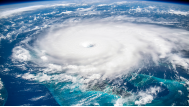
How are typhoons or hurricanes (depending on geography) named? The practice of naming these storms has a long history. Before the 20th century, they were named by the time they appeared or the place where they landed. For example, the hurricane that destroyed Galveston in 1900, killing 6,000 — 12,000 people, is remembered as the Great Galveston Hurricane.
1.1.The writer starts the passage with _______.
A an accident
B an example
C a question
D a fact
解析:选C。C 细节理解题。根据第一段第一句可知,作者以提问开始本文。故选C。
2.2.The Great Galveston Hurricane was named after _______.
A the time
B a place
C a person
D an animal
解析:选B。B 推理判断题。根据第一段中的“the hurricane that destroyed Galveston”可知,加尔维斯顿飓风是根据地名命名的。故选B。
3.3.Why did people use personal names to name storms during World War II?
A To make it easier to remember.
B To name every storm differently.
C To remember someone special.
D To follow the modern system.
解析:选A。A 推理判断题。根据第二段中的“Short and quickly understood, names were easier to send by the radio and easier to keep straight if there was more than one storm in a given area.”可知,二战期间,风暴开始以人名命名,人名简短易懂,更容易通过无线电发送,如果一个地区有不止一个风暴,也更容易区分。由此可推知,人名更容易被记住。故选A。
4.4.The names today should be _______.
A scary
B simple
C famous
D common
解析:选B。B 细节理解题。根据最后一段中的“The names on the list must be short, special, and have something to do with their cultural and geographic areas.”可知,现在台风命名必须简短、特殊,并与他们的文化和地理区域有关。故选B。
5.5.What does the underlined word “recur” probably mean?
A Add.
B Reduce.
C Change.
D Repeat.
解析:选D。D 词义猜测题。根据最后一段划线单词后文的“But if a hurricane or typhoon is especially harmful, that name will not repeat again”但是,如果某个飓风或台风的危害特别大,这个名字就不会再出现了。即一般情况下,名单上的台风名字会重复使用。故选D。